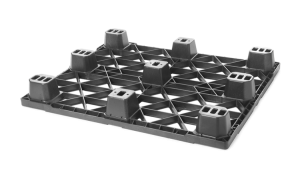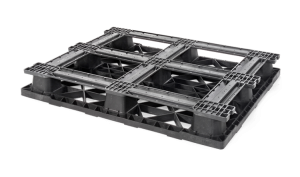Plastic Pallet Types – Let Us Explain!
So you’re interested in the different plastic pallet typess? You’ve come to the right place. We’ll provide our plastic pallet expertise to help you understand the differences between the three main types of pallets.
Type 1: Nestable Plastic Pallets
Design Features
Nestable Plastic Pallet decks are commonly supported by 9 legs and lack runners. Nestable pallet legs are tapered, allowing the legs to nest into one another when stacked. Nestable pallet decks are solid or grated (see also: open, perforated) and are usually designed with nesting registration holes that match the footprint of the pallet legs.
Application

These pallet design features allow empty pallets to stack inside one another, normally achieving a 3-1 ratio, a distinct space saving advantage over a stackable pallet. Some nestable pallets can achieve up a 75% volume reduction during storage and transportation! This space economy reduces the per pallet freight costs & storage space required of empty pallets.
Warning: Nestable Pallets are not designed for double stacking! Stacking nestable pallets on top of sensitive, uneven loads can result is product damage and unsafe working conditions.
Fast Facts:
- 9 Legs (usually)
- No Runners
Recommended For:
- Loads below 3306 lbs
- Saving shipping costs and storage space
Not Recommended For:
- Heavier pallet loads, double stacking
- Roller tracks / Conveyors
Type 2: Stackable Plastic Pallets
Design Features
Stackable Plastic Pallets are designed to stack on top of each other and do not nest inside one another when empty; perfect for stack loading, static storage, and conveyance in manufacturing, warehousing, and processing environments.
Application

Stackable plastic pallet bases are usually provided with 3, 5 or 6 runners. Pallets with bottom runners travel more safely and consistently through a chain or roller conveyor system. Pallet runners also provide additional support and stability for double stacking loaded pallets. Runners work to more evenly distribute the pallet load for more even stacking, reducing the incidence of product damage.
Fast Facts:
- 3,5, or 6 runners
- A 6 runner base is also known as a cruciform base
Recommended For:
- Chain or roller conveyors
- Double stacking loaded pallets
Not Recommended For:
- When empty, efficient storage and space optimized shipping
Type 3: Rackable Plastic Pallets
Design Features & Application
Rackable Plastic Pallets have bases with runners, a cruciform or 6 runner pallet is most common. Rackable pallets are designed to be placed in perimeter racking where pallets are supported on fours sides, but are not supported in the center.
Does Stackable Mean Rackable?
“All certified mail is registered- but registered mail is not necessarily certified”
– Newman (Jerry Seinfeld’s arch enemy)
Huh? Similarly, Rackable pallets are almost always stackable – but stackable pallets are not necessarily rackable!
Load Testing – The Unsung Key To Material Handling Excellence
Of course every “Rackable” plastic pallet has a racking load capacity, but the suitability of the pallet’s capacity should always be tested for this very important reason:
Pallet capacity changes based on the unique properties of each load-
even with loads of identical weight!
Reinforced Plastic Pallets
Some rackable pallets are designed with additional support to boost their load capacity. This is achieved in two ways:
- Reinforcing rods: Some rackable plastic pallets are reinforced with fiberglass or steel rods that pin the pallet deck to the pallet posts, making them stronger in the rack.
- Added plastic: Other rackable pallets are designed with a greater mass of plastic, allowing them to rack without reinforcement rods.
How can we help?
Was that helpful? If you have any questions about plastic pallets or need help finding the best pallet at the most competitive price, please contact our friendly Plastic Pallet Experts.
Tell us what you think!
Care to share? We’d love to hear from you – please leave a comment below.
Want to continue learning more about plastic pallets? Here’s an article we wrote on how to determine pallet capacity!
About Robin Kiefer
Robin Spencer Kiefer connects customers with solutions and products. Robin is the Digital Marketing Manager of One Way Solutions.


 Robin Kiefer
Robin Kiefer  November 3, 2016
November 3, 2016 
Great overview! It’s obvious why there can be so much confusion over which is best. It really depends on how they will be used. Safety is always more important than cost.
Thanks, Jason!
I like the idea of using plastic pallets. I know that it would be nice to have something that is durable. I want to have something that does not have the chance of giving slivers.
Hi. Any chance that you’ll be writing articles with more general pallet handling safety advice?
We are in the home furnishings market. Damaging fancy couches and such on wood pallets led us to plastic pallets. go figure!
Will, absolutely. look for a post on general pallet handling on our blog soon. maybe next week!
Pallets of numerous sizes and materials generally fall into two broad categories: what I call “stringer pallets” and block pallets.
Stringer pallets, are the typical softwood pallets you may already be familiar and are sometimes referred to as “two-way” pallets. Stringer pallets use a frame of three or four pieces of timber (called “stringers”) that are parallel and attached to boards that form the top surface (the “deck boards”). Stringers and deck boards creating the main structure of the pallet. While forklifts can lift this type of pallet from all four directions (although using the stringers to lift is recommended, as it’s safer and more secure), a pallet jack only capable to lift a stringer pallet from only two directions. So consider this when selecting a stringer vs block pallet. Cheers!
Is metal reinforced plastic pallet or plastic pallet with metal insert good for cold storage use?
Yes, those are good for cold storage use – the best would be pallets with freezer additive if that is an option. thank you!